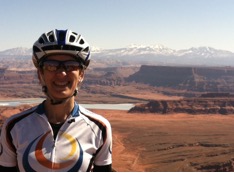 My husband and I recently decided to do a 40 mile bike ride together, hills included. The kicker? We agreed to a goal for sustainable performance, that is, we committed to end the ride with almost as much energy as we started it.
My husband and I recently decided to do a 40 mile bike ride together, hills included. The kicker? We agreed to a goal for sustainable performance, that is, we committed to end the ride with almost as much energy as we started it.
Usually I’m dog-tired at the end of a ride this long, but this time it was simpler than I had expected. Every half mile, we took turns drafting one another, each getting a chance to experience that sweet spot of cycling. It’s there that you draw on the force of the cyclist in front of you and use 40% less energy to get the same results. When drafting like this, yes, you’re still pedaling; your body is still at work. But at the same time, you’re able to rest from the full-exertion grind that can quickly wear you out. This rest gives your muscles a chance to recover– and to maintain energy reserves over the long haul.
In life and leadership, I think of drafting as strategic disengagement, that rare skill of knowing when to take a step away from an action or situation. This break allows you to regain your energy so that, ultimately, you can give it your all.
The value of this skill was reinforced during a daylong energy management workshop I facilitated. I asked each participating leader to assess if he or she was experiencing a personal energy crisis (so named by Tony Schwartz, co-author of The Power of Full Engagement). Most of us are veterans of this kind of crisis, suffering a severe lack of verve at some point in our lives. You know it’s a personal energy crisis when:
- Your thinking is persistently fuzzy
- Your emotions are running too high or too low
- Your stamina peters out before a project is finished, or
- The meaning in life and work has deserted you
The sad fact is that living in an energy deficit can become such a normal state that we no longer know what it feels like to thrive. Many of the leaders in our workshop were nearing burnout (over-challenged) or rustout (under-challenged), and they lacked strong enough energy management skills to handle it. I told them my cycling story and we discussed the benefits of drafting—disengaging in order to re-engage again with replenished energy reserves. Most of these leaders agreed that if they could choose just one skill to renew their vitality, strategic disengagement would be it.
Strategically disengaging means establishing habits which help you intentionally recuperate—mind, body and spirit—over the course of your day (and your life). On a day-to-day basis, this can be done through the routine acts that give you energy, such as eating well, exercising, practicing good sleep hygiene, or using your larger mission, vision, and values to guide how you spend your time. Even those actions which are fewer and further between have their role: getting a monthly massage, taking a bi-yearly retreat completely away from email, or engaging in an altruistic, life-giving project within your community.
When I hopped off the bike after our ride, I can’t say that I wanted to immediately do 40 miles again. But I definitely could have done 39 J. I know it’s counter-intuitive, but for the long haul, sometimes a little strategic disengagement is the only way to fully engage.
For coaching and training on how strategic disengagement, mindfulness, and other tools for thriving can empower your leadership, contact me at renee@wisdom-works.com.
READ MORE
- The Path Of The Evolving Leader: Leadership As Practice
- Seeds of Mindfulness Grow Wellbeing: Aetna’s Innovative Approach
- Resentment: A Potent Medicine For Good
- Is The Planet Ready For A Different Way Of Leading?
- Ready To Boost Leader Effectiveness And Wisdom? Try Mindfulness!
- Success Means Taking Care Of What Enables You To Thrive
- Leading From Authenticity: Boosting Your Energy, Impact, and Wellbeing
- Wellbeing Leadership: Where Are YOU On This Journey?





